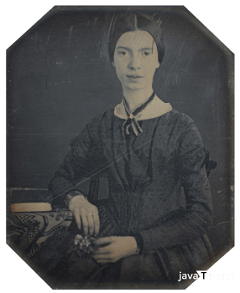Emily Dickinson
IntroductionEmily Dickinson (1830-1886) was an American poet recognized for her distinctive style and exploration of pieces like death, immortality, civilization, nature, and spirituality. Despite being little-recognized during her lifetime, she is now regarded as one of the most influential figures in American poetry. Only 10 of her poems were printed while she was alive, but she authored nearly 1,800. After her death, a collection of her poems was published with heavy editing by acquaintances Thomas Wentworth Higginson and Mabel Loomis Todd. It wasn't until 1955 that scholar Thomas H. Johnson published a complete collection of Dickinson's poetry. In 1998, it was revealed that some edits had been made to exclude the name "Susan," suggesting a possible romantic relationship between Emily and Susan Huntington Gilbert Dickinson. Emily Dickinson's Net Worth
Emily Dickinson BiographyOn December 10, Emily Dickinson was born in 1830 in the lovely city of Amherst, Massachusetts. Her parents were Edward Dickinson and Emily Norcross Dickinson. She had 2 siblings, anointed William Austin Dickinson and Lavinia Norcross Dickinson. Sadly, Emily passed away on May 15, 1886, in Amherst, Massachusetts.
Emily Dickinson CareerEmily Dickinson spent seven years at the academy, excelling in her studies and enjoying her time there. She was troubled by death from a young age, particularly when her close friend Sophia Holland died. This led to a period of melancholy, but she eventually recovered and returned to the academy. During this time, she made lifelong friends and correspondents. In 1845, there was a religious revival in Amherst, which had an impact on Dickinson's peers; however, she did not make a formal declaration of faith herself. After finishing at the academy, Dickinson attended Mount Holyoke Female Seminary for ten months before returning home due to various reasons such as poor health or homesickness. Dickinson befriended Benjamin Franklin Newton at eighteen. He introduced her to the works of Wordsworth, Emerson, and other influential authors. Newton believed in her poetic talent and inspired her to strive for greatness. Dickinson also found inspiration in various books, including Letters from New York, Kavanagh, Jane Eyre, and Shakespeare's plays. During the 1850s, Emily formed a strong and affectionate relationship with her sister-in-law, Susan Gilbert. They exchanged over three hundred letters, and Susan played the role of friend, muse, and advisor to Dickinson. Some have overlooked the significance of their relationship due to biased perspectives from others involved in their lives. Some scholars interpret their relationship as romantic based on the content of their letters. The film Wild Nights with Emily and the TV series Dickinson both explore the relationship between Emily and Susan. Sue married Austin in 1856, but their marriage was unhappy. During this time, Emily's mother became chronically ill, and she withdrew from the outside world. She began creating manuscript books of her poetry and formed a close friendship with Samuel Bowles. In 1862, she contacted Thomas Wentworth Higginson about publishing her work. Her father died in 1874, followed by her mother in 1875. Dickinson had a late-life romance with Otis Phillips Lord until he died in 1884. Emily Dickinson: Relationships & MoreDickinson's private life, involving her romantic connections, remains a topic of curiosity for scholars. Of particular intrigue are the "Master Letters," three drafts of passionate letters written to an unnamed person referred to as "Master."
FAQs1. What is the net worth of Emily Dickinson?Emily Dickinson's net worth is around $4 Million. 2. What was the age of Emily?Emily was 56 years old. (b. December 10, 1830) 3. Was Dickinson married, and with whom?No, she was never married, even unto death.
Next TopicHarald Baldr
|
 For Videos Join Our Youtube Channel: Join Now
For Videos Join Our Youtube Channel: Join Now
Feedback
- Send your Feedback to [email protected]
Help Others, Please Share









